PDF Attached
USDA
crop ratings declined for corn and soybeans. For corn, they were down 5 points, lower than expected, to lowest in decades for this time of year (1988 lowest). Soybeans were down 3 to 51, the lowest since 1996. The trade looked for US G/E corn and soybean ratings
to be down 3, and no change for SW and WW ratings. Spring wheat declined 1 point and winter wheat was unchanged. See tables after the text for production updates.

Choppy
two-sided trade for most commodity markets. Strength in many US ag markets eroded by mid-morning in part to a selloff in US crude oil. Earlier US weather and Black Sea concerns sent most CBOT ag commodity markets higher. Russia instability concerns support
wheat earlier but there was no evidence of a slowdown in Russian wheat exports. USDA export inspections were on the low side for soybeans, corn, and wheat. Global export developments were quiet over the weekend.
The
midday weather update, overall, was viewed as largely unchanged. Rain developed over the weekend across the western and northern Corn Belt but many areas missed out on widespread precipitation, including Illinois, Indiana, and Missouri. The majority of the
US Midwest will be dry until later this week but milder temperatures should slow condition declines bias the dry areas before rising bias the southwestern Corn Belt Wed-Fri. The Canadian Prairies will turn drier over the next week.
Fund
estimates as of June 26 (net in 000)

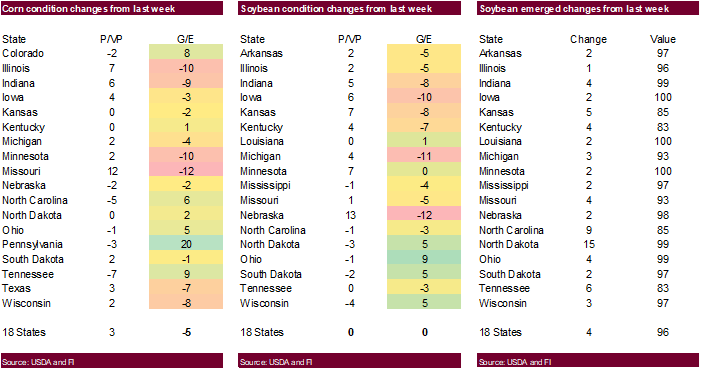
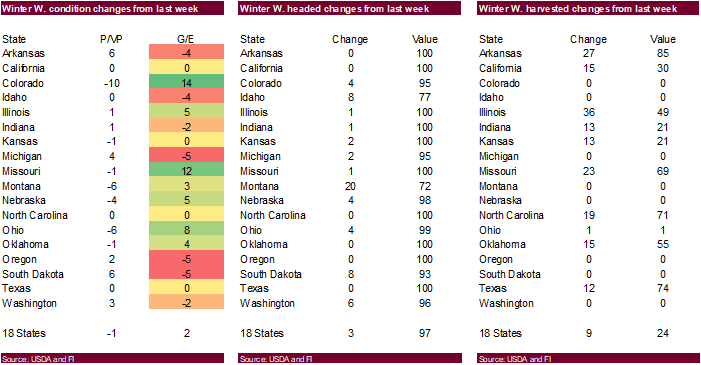

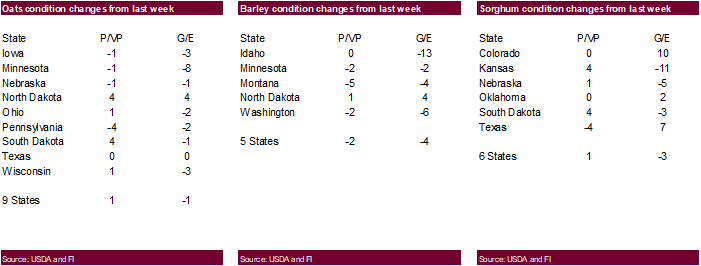
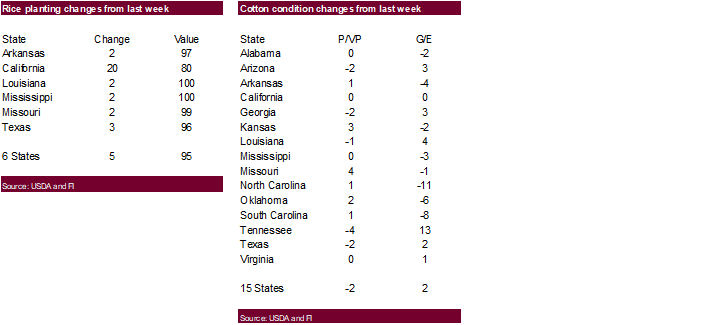
Weather
Last
7 days
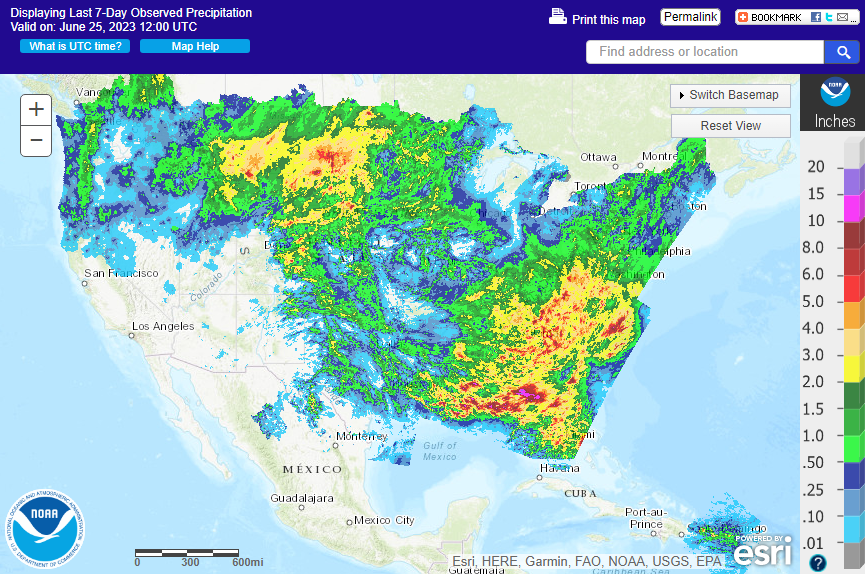
7-day
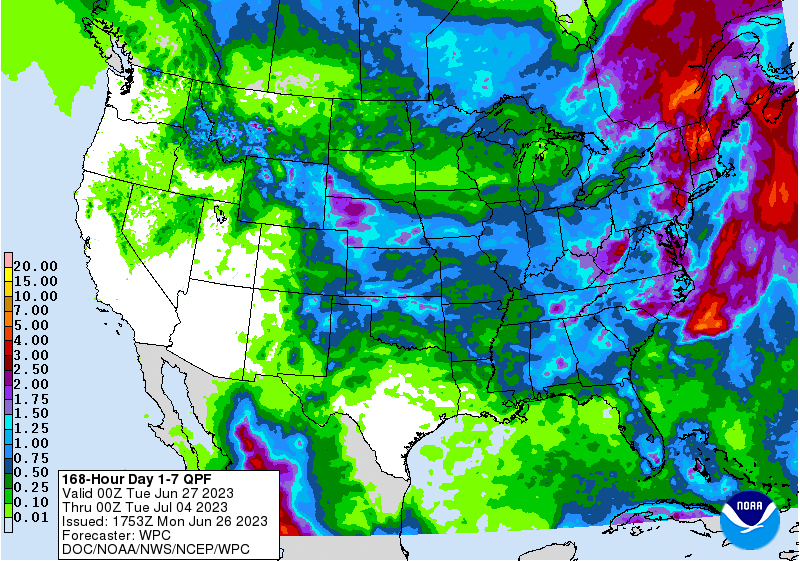
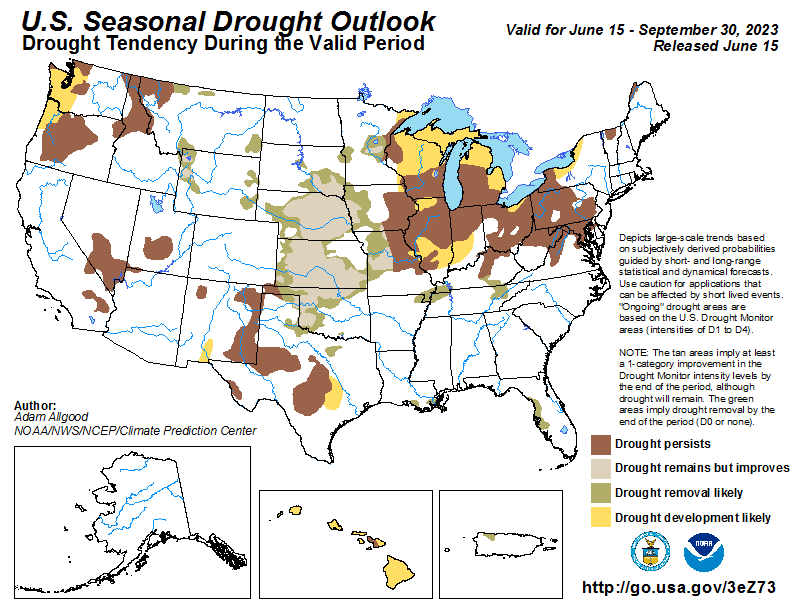
WEATHER
TO WATCH
- Not
much changed overnight; however, there is more evidence that the Gulf of Mexico may open as a moisture source next week and that could bring needed moisture into the eastern Midwest to help improve future rain events - There
is also some additional evidence that the monsoon in Mexico will improve during July with some of that moisture streaming into the Rocky Mountains and eventually across a part of the Plains and into the Midwest - These
changes do not suggest immediate relief, but suggest there is potential for change as time moves along - In
the meantime, concern over low soil moisture will continue in the southwestern and central Corn Belt, despite some increased frequency of rainfall during the next two weeks
- Soil
moisture was becoming critically low across most of the northern and a part of the central Midwest Friday - Weekend
rain brought relief to the eastern Dakotas, portions of Minnesota, northern Iowa and far northern Illinois, northwestern Indiana and parts of both Michigan and Wisconsin, but most other areas failed to get significant moisture - Some
significant rain fell in central and interior eastern Kentucky - Very
warm to hot temperatures in the southwestern and some central U.S. Corn and Soybean production areas during the weekend accelerated evaporation and crop stress expanded in that direction
- The
heat was replaced by some cooling during the latter part of the weekend, but the air remained dry and rainfall was restricted - U.S.
rain during the weekend was most significant in the northern Plains where substantial amounts resulted varying from 1.00 to more than 3.00 inches
- Sand
Lake, South Dakota (located in north-central areas) reported 3.99 inches - The
greatest rain fell from central through northern South Dakota through southern and eastern North Dakota to west-central and northern Minnesota
- Significant
relief to dryness resulted and a much-improved outlook for corn, soybeans, sugarbeets, wheat and other crops resulted - Some
severe thunderstorms accompanied the rain resulting in a little damage from South Dakota and Nebraska into northern Iowa and northern Illinois - Crop
loss should have been very low - Additional
rain is expected periodically over the next week, although it will not be nearly as great and there is still some concern over northwestern North Dakota and northeastern Montana not getting much rain - Another
round of significant rain is possible late this week into Sunday across the Midwest, but it will be scattered and erratic most days early in the period and perhaps greater late in the period - A
majority of the Midwest will get rain at one time or another offering short term relief, but the southwestern corn and soybean production region will be driest leaving that region set for expanding dryness - Relief
elsewhere in the Midwest will be temporary with 0.30 to 0.90 inch of rain expected and local totals of 1.00 to 1.75 inches - Northern
and central areas will be wettest - The
greatest rainfall will be limited to about 30% of the region - The
relief will not last long and it will not be evenly distributed - Subsoil
moisture relief is not very likely - Improvements
in topsoil moisture are expected, but follow up rain will be extremely important - U.S.
temperatures will be cooling down in the Midwest and northern Plains through Wednesday with 70s and lower 80s Fahrenheit likely with some cooler readings in the far north and few warmer readings in the far south - Warming
is expected briefly ahead of the late week rainfall with more hot temperatures coming to the southwestern Corn and Soybean production region - Areas
from Kansas, Missouri and the Delta into southwestern Illinois will get back to the 90s and near 100 degrees Thursday and Friday ahead of the next wave of rain and cooling - Cooling
will return normal to slightly cooler than usual temperatures during the weekend - Rain
advertised for the U.S. Midwest next week will be erratic with some areas getting more rain than others and normal temperatures will be near to above normal - The
environment would not be bad for crops if there was good soil moisture in the ground and no crop stress leading into the period.
- Greater
rain must occur - The
bottom line for the next ten days includes an expansion of drought and dryness intensity in the southwestern U.S. Corn Belt and slow relief for northern, central and eastern parts of the Midwest, although most of the relief is expected to be temporary with
a big need for more routinely occurring rainfall and mild summer temperatures.
- Mexico
drought will continue for one more week and then monsoon moisture is expected to quickly evolve next week finally bringing some relief to that nation - Corn,
sorghum, rice, soybeans and many other crops will be planted aggressively as soon as significant rain falls - Citrus,
sugarcane and coffee conditions will improve with greater rainfall - Mexico’s
drought has delayed early season planting and raised much concern about 2023 summer crop production - Developing
rain will bring an end to that concern - West
Texas cotton areas may begin receiving some needed rain late this week and into the weekend, although it will be sporadic and light
- A
boost in rain is expected briefly next week so that 0.20 to 0.75 inch and locally more impacts much of the region - Follow
up rain will be imperative - U.S.
Delta and southeastern states get a good mix of weather during the coming ten days to two weeks - Some
drying has occurred in the wettest areas in the southeastern states recently and the process will continue for a little while early this week - Temperatures
will be seasonable - GFS
model is still trying to bring a tropical cyclone into the eastern or central Gulf of Mexico next week and then into the southeastern states or perhaps near the Delta around or shortly after July 4 - Confidence
in this feature is low, but not out of the realm of possibilities - U.S.
northern Plains will get additional rain periodically over the next ten days, although it will not be quite as frequent or significant as that of the weekend - Continued
benefits will come to many crops in the region - Canada
Prairies rainfall will continue limited over the next ten days in the southwest and some central locations while rain falls periodically in the far west, north and some eastern crop areas - All
of the moisture will be welcome, but possibly not quite enough to make a serious change in field conditions - Drought
will prevail in southern and east-central Alberta and western Saskatchewan - Temperatures
will be warmer than usual this week and a little closer to normal next week
- The
southeastern Prairies will least likely to get rain - Canada
Prairies weekend rainfall was limited leading to more net drying and rising crop stress in the driest areas of the central and southwest - Ontario
and Quebec, Canada rainfall is expected to be favorably mixed over the next ten days supporting long term crop development potential - Argentina
was dry during the weekend and it will remain that way for the next ten days to two weeks – especially in the west where wheat emergence and establishment has been poor
- Rain
in Argentina during the weekend fell from portions of La Pampa into central and southern Buenos Aires with rainfall of 0.05 to 0.39 inch - The
precipitation was welcome, but had a low impact on struggling crop establishment in the dry areas - Brazil
weekend precipitation was minimal in the south, but showers did produce up to 0.50 inch and temperatures were seasonable - Brazil
weather will be largely dry this week favoring coffee, citrus, sugarcane and Safrinha corn maturation and harvest progress - Wheat
development will improve in the south due to drier weather - Rain
will return to southern Brazil this weekend and especially next week - Waves
of warmer than usual weather will occur in South America over the next ten days - Europe
weather will be favorably mixed over the next ten days, but rainfall volume will remain a little light leaving need for greater moisture to fix long-term moisture deficits - Temperatures
will be near to above normal - Most
crops are in fair to good condition, but there is need for more rain in many areas to bring back the good the excellent ratings that have slipped away in recent weeks - A
favorable mix of rain and sunshine is expected in most Russia, Ukraine, Belarus, Baltic States and northern Kazakhstan crop areas during the next ten days - Temperatures
will become seasonable to slightly warmer biased after cool weather abates this week - Xinjiang,
China will be a little milder than usual over the coming ten days and rainfall will be minimal - Crop
conditions should stay mostly good - China
crop areas north of the Yellow River will remain drier than usual in the coming ten days to two weeks with temperatures near to above normal - Some
crop stress is expected for unirrigated crops, but mostly for spring wheat, sunseed and sugarbeets - Only
a small part of the corn crop would be impacted - Most
other areas in China will experience a good mix of weather with sufficient rain to support long term crop development - Some
delay to early rice harvesting will continue - Excessive
rain in early rice production areas of southern China during the weekend likely caused some crop damage - Rain
totals varied from 4.20 inches to more than 13.74 inches - Sugarcane
and some minor corn, soybeans and groundnuts were also impacted - Areas
from Guangxi to Zhejiang were most impacted - Outside
of far southern China, the weekend was dry and warm to hot with highs in the 90s to 104 degrees Fahrenheit across the North China Plain and areas north of the Yellow River - All
of Southeast Asia continued to deal with erratic rainfall during the weekend and this pattern may prevail for a while
- Daily
showers and thunderstorms are expected and that will help slow the drying trend, but there will be days of no rain and warm temperatures to induce some drying
- India
weekend rainfall began to increase and the moisture was welcome, although much more was needed after a slow start to the rainy season
- India
will experience greater rain more often in central parts of the nation during the next ten days to two weeks and soil moisture will be bolstered sufficiently for planting of summer crops - West-central
and southern India will experience lighter than usual rainfall which may have an impact on sugarcane and rice with some concern over late season cotton, groundnuts and other crops that are usually planted late in the monsoon season - Rain
is still being advertised for Queensland and northern New South Wales, Australia this coming weekend and early next week - The
event has been diminished from that of Friday which was needed, but there will still be some benefits for the wheat, barley and limited amounts of canola produced in these areas - Rain
is needed to improve emergence and establishment in unirrigated fields - Other
areas in Australia will not receive as much rain as in previous weeks, but winter crops should be establishing well - Central
America rainfall has been timely recently and mostly good for crops, although many areas are still reporting lighter than usual amounts - A
boost in rainfall is expected over the next ten days - Drought
continues to impact Gatlin lake and the Panama Canal shipments, but some increase in precipitation is forthcoming - Tropical
Storm Bret dissipated over the Caribbean Sea during the weekend - Tropical
Storm Cindy dissipated over open water in the Atlantic Ocean overnight - There
were no other areas of disturbed tropical weather in the Atlantic Ocean, Caribbean Sea or Gulf of Mexico being monitored Sunday by the U.S. National Hurricane Center for the coming week - Two
tropical cyclones may evolve in the eastern Pacific Ocean this week southwest of Mexico and northwest of the upper Pacific coast of Central America - Both
systems should parallel the west coast of Mexico, but no landfall is expected - South
Africa winter crops will experience a couple of waves of rain during the next two weeks that will ensure a well-established wheat, barley and canola crop this year - West-central
Africa crop conditions remain good with little change expected - Rain
will fall in a timely manner during the next two weeks - East-central
Africa weather will continue favorable for coffee, cocoa, sugarcane, rice and other crops through the next two weeks -
Today’s
Southern Oscillation Index was -5.47 and it will move erratically higher over the next few days
Source:
World Weather, INC.
Monday,
June 26:
- USDA
export inspections – corn, soybeans, wheat, 11am - US
corn, cotton, soybean, spring wheat and winter wheat condition, 4pm - US
planting data for cotton, spring wheat and soybeans, 4pm - US
poultry slaughter, 3pm
Tuesday,
June 27:
- EU
weekly grain, oilseed import and export data
Wednesday,
June 28:
- Canada’s
StatCan to release seeded area data for wheat, barley, canola and soybeans - EIA
weekly US ethanol inventories, production, 10:30am - HOLIDAY:
India, Indonesia
Thursday,
June 29:
- IGC
monthly grains report - USDA
weekly net-export sales for corn, soybeans, wheat, cotton, pork and beef, 8:30am - Vietnam’s
coffee, rice and rubber export data for June - Port
of Rouen data on French grain exports - USDA
hogs and pigs inventory, 3pm - HOLIDAY:
Indonesia, Malaysia, Singapore, Pakistan
Friday,
June 30:
- USDA
quarterly stockpiles data for corn, soybeans, wheat, barley, oat and sorghum, noon - ICE
Futures Europe weekly commitments of traders report - US
annual acreage data for corn, cotton, wheat and soybeans - US
agricultural prices paid, received, 3pm - CFTC
commitments of traders weekly report on positions for various US futures and options, 3:30pm - FranceAgriMer’s
weekly crop condition report - HOLIDAY:
Indonesia, Pakistan
Source:
Bloomberg and FI
Canada
plantings. June 28 release (7:30 am CDT)
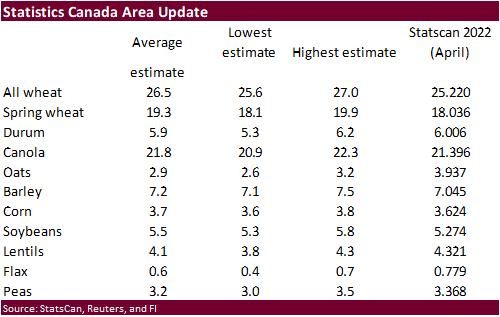
Reuters
estimates for June 30 USDA reports



Bloomberg
Estimates
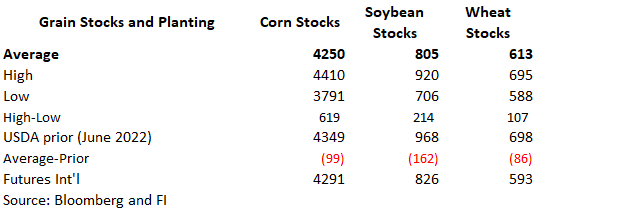
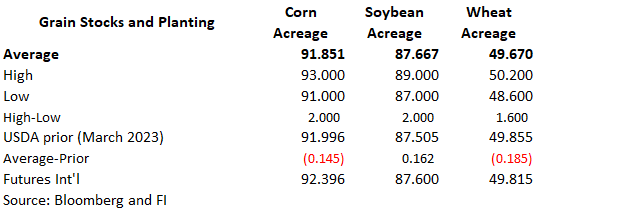
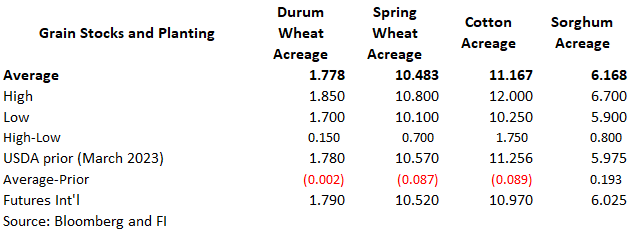
USDA
inspections versus Reuters trade range
Wheat
203,724 versus 200000-400000 range
Corn
542,727 versus 700000-1250000 range
Soybeans
141,158 versus 125000-300000 range

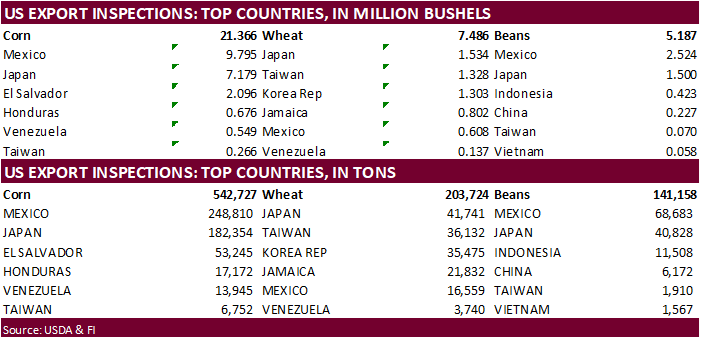
GRAINS INSPECTED AND/OR WEIGHED FOR EXPORT
REPORTED IN WEEK ENDING JUN 22, 2023
-- METRIC TONS --
-------------------------------------------------------------------------
CURRENT PREVIOUS
----------- WEEK ENDING ---------- MARKET YEAR MARKET YEAR
GRAIN 06/22/2023 06/15/2023 06/23/2022 TO DATE TO DATE
BARLEY 0 0 49 0 49
CORN 542,727 830,999 1,246,950 32,477,480 47,427,940
FLAXSEED 0 0 0 0 0
MIXED 0 0 0 0 0
OATS 0 0 1,297 799 1,297
RYE 0 0 0 0 0
SORGHUM 63,546 1,294 148,696 1,843,761 6,689,131
SOYBEANS 141,158 179,548 476,951 49,165,385 51,436,105
SUNFLOWER 0 96 0 2,704 2,260
WHEAT 203,724 235,175 352,894 757,349 1,339,828
Total 951,155 1,247,112 2,226,837 84,247,478 106,896,610
--------------------------------------------------------------------------
CROP MARKETING YEARS BEGIN JUNE 1 FOR WHEAT, RYE, OATS, BARLEY AND
FLAXSEED; SEPTEMBER 1 FOR CORN, SORGHUM, SOYBEANS AND SUNFLOWER SEEDS.
INCLUDES WATERWAY SHIPMENTS TO CANADA.
Macros
102
Counterparties (prev 101) Take $1.961 Tln (prev $1.969 Tln) At Fed Reverse Repo Op.
Canada
Wholesales Rose 3.5% M/M In May – Statcan Flash
Canada
Factory Sales Rose 0.8% M/M In May
Putin
Extends Until The End Of 2023 Russia’s Response Measures To The Price Cap On Russian Oil And Oil Products – Decree
·
US corn futures traded two-sided, ending mostly higher as traders had mixed thoughts over past and future US weather. Some of the dry areas of the heart of the Midwest saw rain over the weekend into Monday, but much more is needed
with corn heading into the pollination stage. If the weather forecast remains drier than normal for the month of July, we would tend to think it would be a corn problem more so than soybeans, which are “made” during the month of August. Therefore, it was interesting
to see corn lose against soybeans today.
·
Corn prices were choppy today on mixed thoughts over the US weather forecast and potential Russia political instability. This was reflected in the open Sunday night for December corn which saw a 12.5 cents range during the first
60 seconds of trade.
·
USDA US corn export inspections as of June 22, 2023, were 542,727 tons, within a range of trade expectations, below 830,999 tons previous week and compares to 1,246,950 tons year ago. Major countries included Mexico for 248,810
tons, Japan for 182,354 tons, and El Salvador for 53,245 tons.
·
A good portion of the Midwest saw rain over the weekend but many hard-hit dry areas didn’t see much rain, if any. Rain was greatest from the eastern Dakotas and northeastern Nebraska to Wisconsin and northern Illinois. Monday
was mostly dry.
·
Rain during the next two weeks will be below normal for the Midwest, but just enough to support early pollination.
·
Brazil’s second crop corn harvest advanced about 4 points to 9 percent complete, well below 20 percent for this time year ago, according to AgRural. They are at 127.4 million tons for total corn production.


Export
developments.
-
None
reported
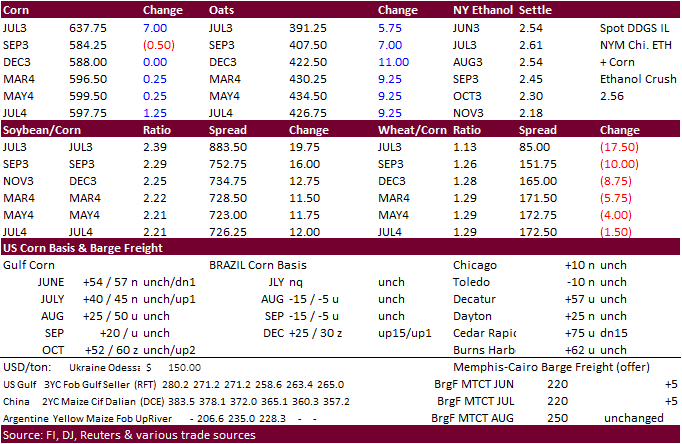
Price
outlook (6/23/23)
September
corn $5.25-$7.00
December
corn $480-$7.25
·
Soybeans were higher in part to less than ideal US weather and higher products coupled with rising domestic product basis as crushers enter seasonal downtime. Many of these crushing plants have been running full steam for months,
so it is no surprise to take maintenance for about a week. Meal basis in central IL rallied late last week and selected soybean oil basis locations also appreciated over the past seven days. US soybean oil basis firmed last week to 425 over from 350 for central
IL and Gulf to 550 over from 500 over previous week.
·
Vegetable oil prices were higher in Europe and Malaysia on Monday over Russia export concerns from political stability. Over the weekend the Wager Group reversed their decision to march on Moscow.
·
USDA US soybean export inspections as of June 22, 2023, were 141,158 tons, within a range of trade expectations, below 179,548 tons previous week and compares to 476,951 tons year ago. Major countries included Mexico for 68,683
tons, Japan for 40,828 tons, and Indonesia for 11,508 tons.
·
ITS reported June 1-25 Malaysian palm oil exports at 897,180 tons from 982,605 tons same period month earlier. AmSpec reported 891,361 tons from 933,615 tons the previous month. During the regular session Monday, third month Malaysian
palm oil futures increased 99 ringgit to 3719, and cash increased $17.50 to $875/ton.

-
China
will auction off 306,700 tons of imported soybeans from state reserves on June 27.
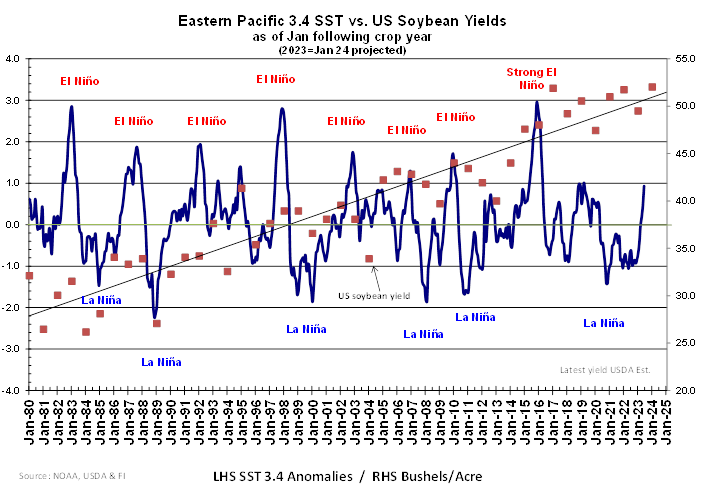
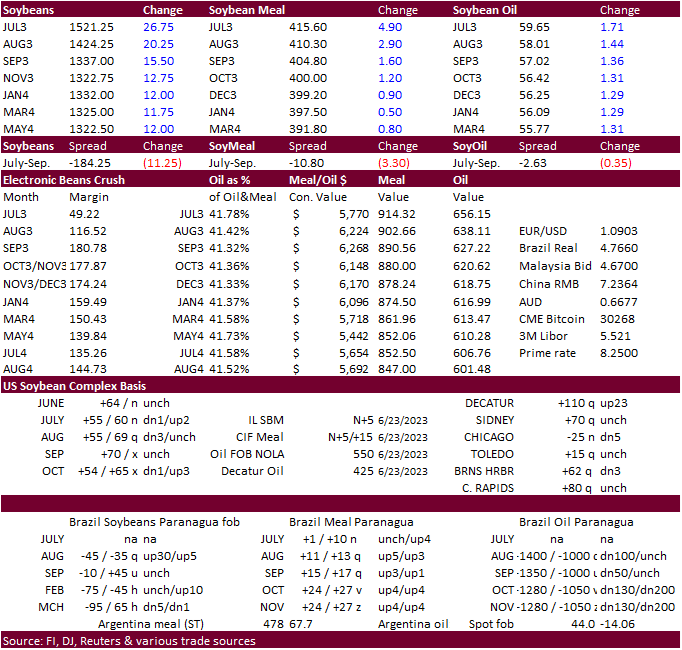
Price
outlook (6/23/23)
Soybeans
– September $14.00-$15.50, November $12.00-$15.25
Soybean
meal – September $360-$475, December $350-$500
Soybean
oil – September 51.00-58.00, December 48.00-58.00
·
US wheat futures ended mixed with Chicago on the defensive KC higher, and Minneapolis lower in the front three contracts and higher in the back months. Earlier all three markets were higher on renewed Black Sea concerns amid Russia
instability. Earlier, this also affected vegetable oils and corn.
·
USDA US all-wheat export inspections as of June 22, 2023, were 203,724 tons, within a range of trade expectations, below 235,175 tons previous week and compares to 352,894 tons year ago. Major countries included Japan for 41,741
tons, Taiwan for 36,132 tons, and Korea Rep for 35,475 tons.
·
Much needed rain fell across the weekend for west Texas and Oklahoma, too late for wheat but beneficial for Cotton and other crops. Harvesting will increase for the central Great Plains this week.
·
It will be hot again across the southern Great Plains July 6-10.
·
September Paris milling wheat officially closed 2.00 euros lower, or 0.8%, at 246.25 euros a ton (about $268.50 ton).
·
Iraq bought more than 4.5 million tons of local wheat.
·
We don’t see any near-term impact on Russia agricultural exports from potential political instability. Some think Russia export prices will increase this week. On Monday AgriCensus reported mostly unchanged wheat prices for Russia
main ports. Russia wheat prices did increase last week. IKAR reported as of Friday 12.5 percent protein at $231 per ton, up $3.00 from the prior week.
·
(Reuters) – The European Union’s crop monitoring service MARS on Monday forecast that Russia’s total wheat production will shed 17% compared to 2022 to 86.7 million metric tons, though that would still be 4% above the five-year
average. In a report MARS also pegged the country’s total barley output in 2023 at 20.4 million tons, down 11% on year, and the grain maize crop at 15.2 million tons, up 1%.
·
Ukraine completed spring grain and oilseed plantings.
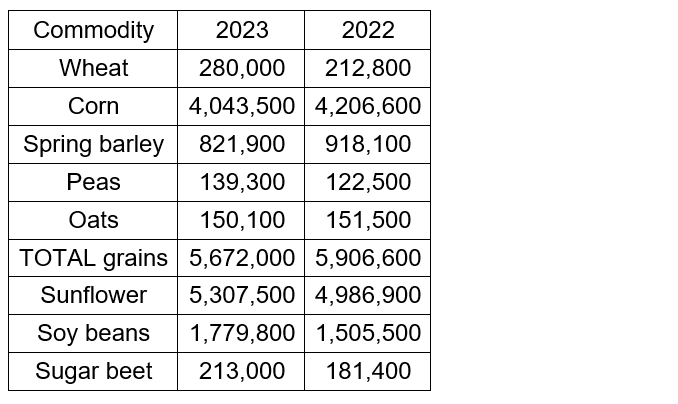
SovEcon
raised
their June Russia wheat export outlook by 200,000 tons.

CME
Variable
Storage Rate (VSR) Results for Wheat and KC HRW Wheat Premium (Storage) Rates
https://www.cmegroup.com/notices/ser/2023/06/SER-9211.html
Export
Developments.
·
None reported
Rice/Other
China
sold 78,984 tons of rice or 8.75 percent of what was offered from state reserves at an average price of 2,559 yuan per ton.
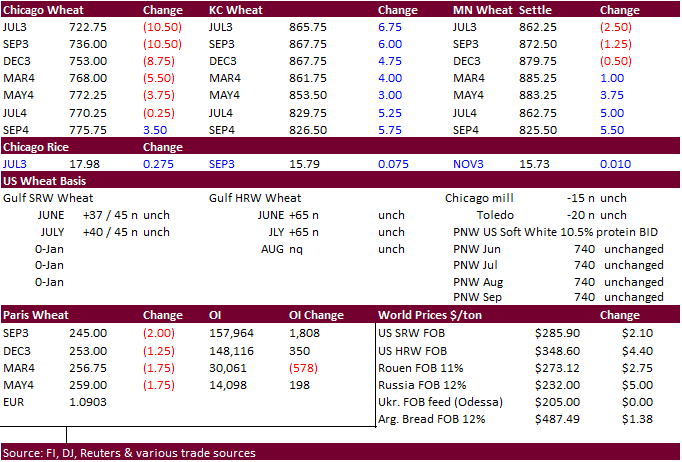
Price
outlook (6/23/23)
Chicago
Wheat September $6.00-$8.25
KC – September $7.25-$9.50
MN – September $7.25-$9.50
#non-promo
